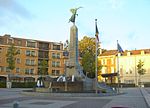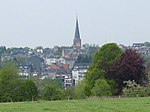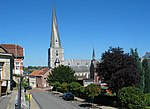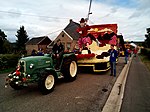Eupen (German: [ˈɔʏpn̩] , French: [øpɛn] , Dutch: [ˈøːpə(n)] ; Ripuarian: Ööpe [ˈøːpə]; Walloon: Neyåw [nɛjɑːw]; former French: Néau [neo]) is the capital of German-speaking Community of Belgium and is a city and municipality in the Belgian province of Liège, 15 kilometres (9 miles) from the German border (Aachen), from the Dutch border (Maastricht) and from the "High Fens" nature reserve (Ardennes). The town is also the capital of the Euroregion Meuse-Rhine.
First mentioned in 1213 as belonging to the Duchy of Limburg, possession of Eupen passed to Brabant, Burgundy, the Holy Roman Empire and France before being given in 1815 to Prussia, which became part of the new German Empire in 1871. In 1919, after the First World War, the Treaty of Versailles transferred Eupen and the nearby municipality of Malmedy from Germany to Belgium.
German remains the official language in Eupen (also spoken in the form of the Eupen dialect), and the city serves as the capital for Belgium's German-speaking Community. The city has a small university, the Autonome Hochschule in der deutschsprachigen Gemeinschaft, offering bachelor's degrees in Education and Nursing. In 2010, Eupen's association football team, K.A.S. Eupen, became the first club from the German-speaking Community to play in the Belgian Pro League.
On 1 January 2006, Eupen had a total population of 18,248 (8,892 males and 9,356 females). The total area is 103.74 km2 (40.05 sq mi) which gives a population density of 175.90 inhabitants per km2.









